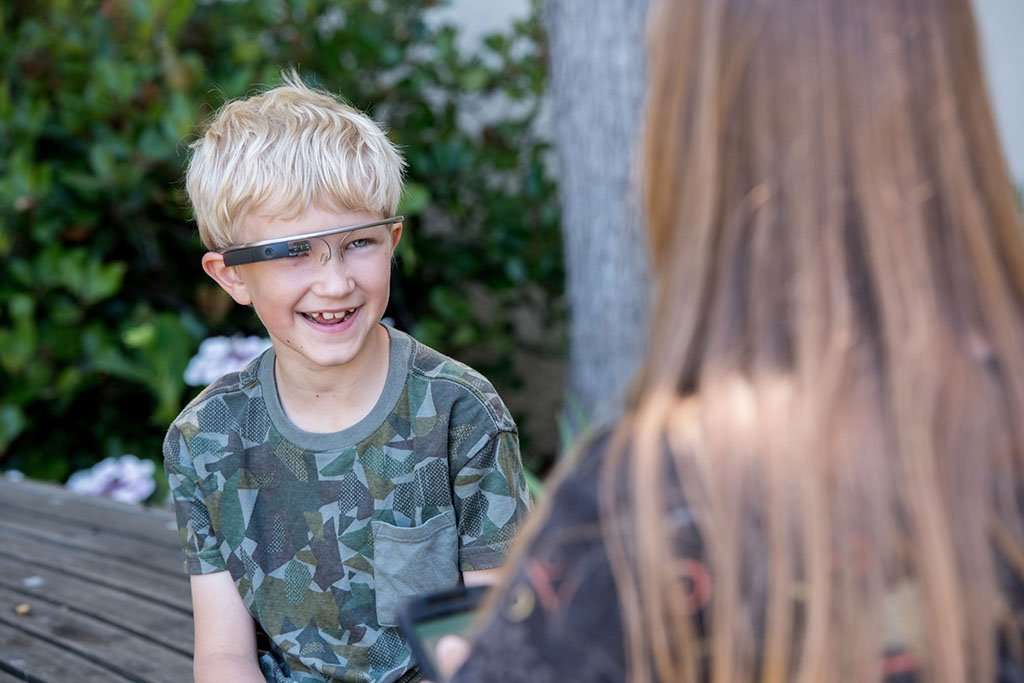Children with autism were able to improve their social skills by using a smartphone app paired with Google Glass to help them understand the emotions conveyed in people’s facial expressions, according to a pilot study by researchers at the Stanford University School of Medicine.
Prior to participating in the study, Alex, 9, found it overwhelming to look people in the eye. Gentle encouragement from his mother, Donji Cullenbine, hadn’t helped. “I would smile and say things like, ‘You looked at me three times today!’ But it didn’t really move the bar,” she said. Using Google Glass transformed how Alex felt about looking at faces, Cullenbine said. “It was a game environment in which he wanted to win — he wanted to guess right.”
The therapy, described in findings published online Aug. 2 in npj Digital Medicine, uses a Stanford-designed app that provides real-time cues about other people’s facial expressions to a child wearing Google Glass. The device, which was linked with a smartphone through a local wireless network, consists of a glasses-like frame equipped with a camera to record the wearer’s field of view, as well as a small screen and a speaker to give the wearer visual and audio information. As the child interacts with others, the app identifies and names their emotions through the Google Glass speaker or screen. After one to three months of regular use, parents reported that children with autism made more eye contact and related better to others.
The treatment could help fill a major gap in autism care: Right now, because of a shortage of trained therapists, children may wait as long as 18 months after an autism diagnosis to begin receiving treatment.
“We have too few autism practitioners,” said the study’s senior author, Dennis Wall, PhD, associate professor of pediatrics and of biomedical data science. Early autism therapy has been shown to be particularly effective, but many children aren’t treated quickly enough to get the maximum benefit, he said. “The only way to break through the problem is to create reliable, home-based treatment systems. It’s a really important unmet need.”
Autism is a developmental disorder that affects 1 in 59 children in the United States, with a higher prevalence in boys. It is characterized by social and communication deficits and repetitive behaviors.
The researchers named the new therapy “Superpower Glass” to help make it appealing to children. The therapy is based on applied behavior analysis, a well-studied autism treatment in which a clinician teaches emotion recognition using structured exercises such as flash cards depicting faces with different emotions. Although traditional applied behavior analysis helps children with autism, it has limitations: It must be delivered one-on-one by trained therapists, flash cards can’t always capture the full range of human emotion and children may struggle to transfer what they learn to their daily lives.
Wall’s team decided to try using applied behavior analysis principles in a way that would bring parents and everyday situations into the treatment process. They built a smartphone app that uses machine learning to recognize eight core facial expressions: happiness, sadness, anger, disgust, surprise, fear, neutral and contempt. The app was trained with hundreds of thousands of photos of faces showing the eight expressions, and also had a mechanism to allow people involved in the study to calibrate it to their own “neutral” faces if necessary.

tellthefolksathome on August 4th, 2018 at 15:58 UTC »
"The results should be interpreted with caution since the study did not have a control arm, Wall said."
So, basically, there is no evidence that this treatment is any more effective than 60 minutes a week of therapy addressing social thinking, or the ABA therapy on which this study was based.
helperwolf on August 4th, 2018 at 15:43 UTC »
Google has a facial recognition program that is a available to the public in their camera stem project kit. I figure if someone can take that and install it into a dyi 3d printed Google glass knockoff (theres a few tutorials out there), they'd essentially have the same thing.
mvea on August 4th, 2018 at 13:56 UTC »
Journal reference:
Exploratory study examining the at-home feasibility of a wearable tool for social-affective learning in children with autism
Jena Daniels, Jessey N. Schwartz, Catalin Voss, Nick Haber, Azar Fazel, Aaron Kline, Peter Washington, Carl Feinstein, Terry Winograd & Dennis P. Wall
npj Digital Medicine, volume 1, Article number: 32 (2018)
DOI: https://doi.org/10.1038/s41746-018-0035-3
Link: https://www.nature.com/articles/s41746-018-0035-3
Abstract
Although standard behavioral interventions for autism spectrum disorder (ASD) are effective therapies for social deficits, they face criticism for being time-intensive and overdependent on specialists. Earlier starting age of therapy is a strong predictor of later success, but waitlists for therapies can be 18 months long. To address these complications, we developed Superpower Glass, a machine-learning-assisted software system that runs on Google Glass and an Android smartphone, designed for use during social interactions. This pilot exploratory study examines our prototype tool’s potential for social-affective learning for children with autism. We sent our tool home with 14 families and assessed changes from intake to conclusion through the Social Responsiveness Scale (SRS-2), a facial affect recognition task (EGG), and qualitative parent reports. A repeated-measures one-way ANOVA demonstrated a decrease in SRS-2 total scores by an average 7.14 points (F(1,13) = 33.20, p = <.001, higher scores indicate higher ASD severity). EGG scores also increased by an average 9.55 correct responses (F(1,10) = 11.89, p = <.01). Parents reported increased eye contact and greater social acuity. This feasibility study supports using mobile technologies for potential therapeutic purposes.